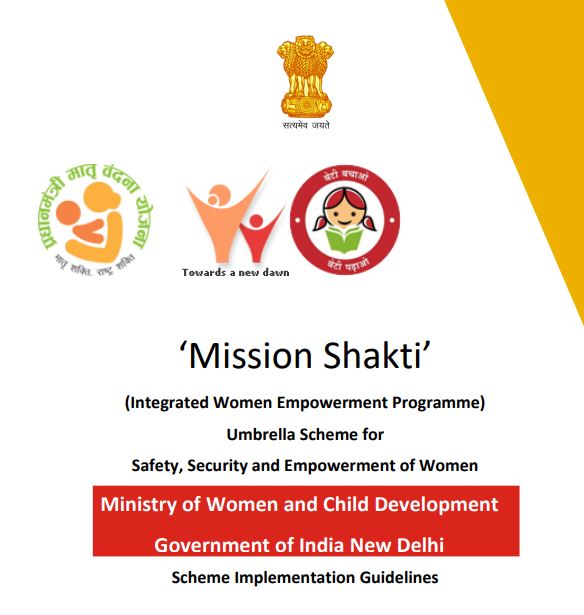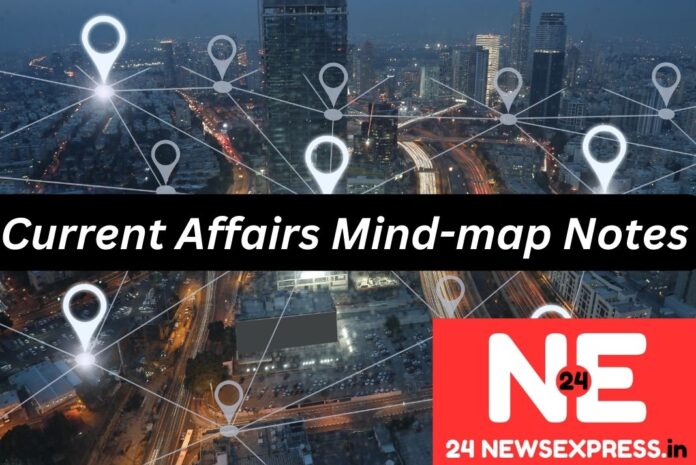Notes from daily Drishti IAS Current Affairs arranged in the mind map form, which helps students in retaining information without losing any key points. Credits for the main contents belongs to the Drishti IAS Current Affairs.
Table of Contents
Suggested Read: National Crime Records Bureau Crime Report 2022:Bengaluru ranked highest in cybercrime
1. Drishti IAS Current Affairs: Global Positioning System (GPS)

About GPS:
o Initiated by US Department of Defense in 1973
o Launched first satellite in 1978
o Modern constellation: 24 satellites in 6 orbits
o Each satellite completes 2 orbits/day
3 main components:
Space Segment
- 24 satellites
- 6 orbits at 20,200 km
- 4 satellites/orbit
- Continuously broadcast signals
- L1 and L2 frequencies
- Code-division multiple access
- Coarse/acquisition mode (civilian)
- Precise mode (military)
Control Segment
- Global network of ground stations
- Tracks satellites
- Ensures performance (SPS standards)
User Segment (Diverse applications)
- Agriculture
- Construction
- Surveying
- Logistics
- Telecommunications
- Power transmission
- Search and rescue
- Air travel
- Meteorology
- Seismology
- Military operations
How it works?
o Satellites broadcast signals (location, time)
o Signals received by GPS receiver
o Receiver calculates distance from satellite
o Requires signals from at least 4 satellites for accurate positioning
- Other countries with GNSS:
o Australia
o China
o EU (Galileo)
o India (NavIC)
o Japan
o South Korea
o Russia (GLONASS)
o UK - India’s NavIC:
o 7 satellites (3 geostationary, 4 geosynchronous)
o Minimum 4 satellites for ground-based navigation
o Master control facilities: Hassan (Karnataka) & Bhopal (MP)
o Rubidium atomic clocks
o Data transmission: L5, S, and L1 (new satellites)
o Messaging interface for warnings (fishers) - GAGAN System:
o Developed by ISRO and Airports Authority of India
o Provides correction and integrity messages for GPS
o Primary purpose: safety-of-life civil aviation applications - Current Scenario:
o 6.5 billion GNSS devices worldwide (2021)
o Expected to reach 10 billion by 2031
UPSC Previous Year Question (PYQ):
1. Which one of the following countries has its own Satellite Navigation System? (2023)
a. Australia
b. Canada
c. Israel
d. Japan
Ans: d
2 With reference to the Indian Regional Navigation Satellite System (IRNSS), consider the following statements: (2018)
1. IRNSS has three satellites in geostationary and four satellites in geosynchronous orbits.
2. IRNSS covers entire India and about 5500 sq. Km beyond its borders.
3. India will have its own satellite navigation system with full global coverage by the middle of 2019.
Which of the statements given above is/are correct?
(a) 1 only
(b) 1 and 2 only
(c) 2 and 3 only
(d) None
Ans: (a)
Mains:
1. Why is Indian Regional Navigational Satellite System (IRNSS) needed? How does it help in navigation?(2018)
Suggested Read: Combating Dark Patterns: India Takes a Stand for Consumer Protection in the Digital Age
2. Drishti IAS Current Affairs: Simultaneous Elections in India
- About:
Simultaneous elections: Holding elections for Lok Sabha, State assemblies, and local bodies at the same time.
Aims to synchronize electoral cycles and conduct all elections together, ideally once every five years.
Historical context: Initial four general elections in India had simultaneous elections. - Benefits:
Resource Efficiency: Significant financial savings.
Optimized Administration: Streamlines deployment of security forces and administrative staff.
Continuity in Policies: Fewer interruptions due to Model Code of Conduct.
Enhanced Voter Turnout: Reduced voter fatigue and increased participation.
Increased Accountability: Politicians held accountable across different tiers.
Reduced Polarization: National issues brought to the forefront. - Challenges:
Constitutional Amendments: Requires changes to various articles.
Federalism Concerns: Requires consensus among states with diverse political landscapes.
Technology and Infrastructure: Upgrading EVMs and VVPATs on a large scale.
By-elections and Legislative Councils: Potential gaps in representation.
Diverse Political Landscapes: May overlook regional issues and dilute representation. - Law Commission Stance:
Draft report in August 2018 examined challenges and proposed solutions.
Proposed Framework:
Reducing Election Cycles: Holding elections twice in five years.
Conducting All Elections in a Calendar Year: As an alternative.
Constructive Vote of No-Confidence Motion: For government continuity.
Hung House Resolution: Process for resolving no-majority situations.
Timely Disqualification: Swift resolution of disqualification cases.
Panel discussion in October 2023 to discuss roadmap for synchronizing elections by 2029. - Conclusion:
Requires a measured, consultative approach balancing benefits with complexities.
Incremental steps, stakeholder consultations, and adaptable frameworks are key.
3. Drishti IAS Current Affairs: Grain Storage Plan in Cooperative Sector
Why in News?
• The Ministry of Cooperation has initiated the “World’s Largest Grain Storage Plan in Cooperative Sector” to address the shortage of storage capacity for food grains.
What is the Plan?
• Comprehensive Infrastructure Creation: Establishing various agricultural infrastructures at Primary Agricultural Cooperative Societies (PACS) levels, including warehouses, custom hiring centers, processing units, Fair Price Shops, etc.
• Convergence of existing schemes: AIF, AMI, SMAM, PMFME, PMKSY, MIDH.
• Implementation Partners: NCDC, NABARD, FCI.
• Pilot Project: 1,711 PACS identified for inclusion.
• Committees for Oversight: IMC, NLCC, SCDCs, DCDCs.
Impact on Farmers:
• Storage and bridge finance: Access to godowns and loans.
• MSP and market flexibility: Sell produce at preferred time or at MSP.
• Reduced post-harvest losses: Decentralized storage capacity.
• Cost savings: PACS as procurement centers and FPS.
• Easy access to inputs: Available at Panchayat/village level.
• Diversification opportunities: Beyond traditional farming.
• National food security: Enhanced storage capacity and reduced wastage.
Additional Information:
• PACS: Grassroots level arms of the cooperative credit structure.
• AIF: Creates post-harvest management infrastructure.
• PM-AASHA: Provides MSP for oilseeds, pulses & copra.
• MIS: Procures perishable commodities to protect growers from distress sales.
• BBSSL: Umbrella organization for improved seed production and distribution.
Previous Year Questions (PYQs)
1) Consider the following statements: (2020)
1. In terms of short-term credit delivery to the agriculture sector, District Central Cooperative Banks (DCCBs) deliver more credit in comparison to Scheduled Commercial Banks and Regional Rural Banks.
2. One of the most important functions of DCCBs is to provide funds to the Primary Agricultural Credit Societies.
Which of the statements given above is/are correct?
(a) 1 only
(b) 2 only
(c) Both 1 and 2
(d) Neither 1 nor 2
Ans: (b)
2) With reference to ‘Urban Cooperative Banks’ in India, consider the following statements:(2021)
1. They are supervised and regulated by local boards set up by the State Governments.
2. They can issue equity shares and preference shares.
3. They were brought under the purview of the Banking Regulation Act, 1949 through an Amendment in 1966.
Which of the statements given above is/are correct?
(a) 1 only
(b) 2 and 3 only
(c) 1 and 3 only
(d) 1, 2 and 3
Ans: (b)
Mains
1. In the villages itself no form of credit organization will be suitable except the cooperative society.” – All India Rural Credit Survey. Discuss this statement in the background of agricultural finance in India. What constraints and challenges do financial institutions supplying agricultural finance face? How can technology be used to better reach and serve rural clients? (2014)
4. Drishti IAS Current Affairs: India Infrastructure Report 2023
Why in News?
The India Infrastructure Report (IIR) 2023, focusing on urban planning and development, was recently released. It is a comprehensive document covering various aspects of infrastructure planning, finance, and governance in India.
A collaborative effort by IDFC Foundation, Infrastructure Development Corporation (Karnataka) Ltd. (iDeCK), and National Institute of Urban Affairs (NIUA).
Key Highlights:
- Thematic Focus on Urban Challenges:
Addresses key challenges like planning and governance, smart initiatives, public-private partnerships (PPPs), and financing.
Highlights housing and migration, public service delivery, integrating infrastructure, and urban redevelopment. - Critique of Planning Mechanism:
- Criticizes existing planning mechanisms, particularly restrictions on building construction, for causing urban sprawl and slums.
- Links low Floor Space Indices (FSIs) to high-density development and urban sprawl.
- Advocates for dynamic city building and increasing carrying capacity with urban growth.
- Financial Management of Urban Local Bodies:
Emphasizes the urgent need for financial sustainability.
Advocates for PPPs and municipal bonds as essential tools for financing urban development projects.
Report notes that while India has led in PPPs, few have happened in the urban sector. - India Infrastructure Report (IIR):
- Contains 25 chapters by prominent figures in the urban development and policy ecosystem.
- An invaluable resource for policymakers, investors, academics, financiers, and multilateral agencies.
- Current Urban Landscape in India:
- India is one of the fastest-growing economies, propelled by its cities.
- Cities contribute 66% to the national GDP, expected to rise to 80% by 2050.
- Urbanization has been relatively slow, growing at just over 1.15% annually from 2001-2011.
- Initiatives Related to Urban Development:
Smart Cities
Swachh Bharat Mission-Urban
HRIDAY
Aspirational district program
Atal Mission for Urban Rejuvenation and Urban Transformation (AMRUT)
Pradhan Mantri Awas Yojana-Urban (PMAY-U)
Climate Smart Cities Assessment Framework 2.0
TULIP-The Urban Learning Internship Program
Atmanirbhar Bharat Abhiyan (Self-Reliant India)
Additional Information:
1. IDFC Foundation supports social infrastructure, research, and advocacy in India.
2. iDeCK works on sustainable infrastructure projects and supports research through IDFC Foundation and ICAP Trust.
The report's analysis of the financial management of urban local bodies highlights the urgent need for financial sustainability.
3. The report advocates for PPPs and municipal bonds as essential tools for financing urban development projects.
Conclusion:
The India Infrastructure Report 2023 provides valuable insights into the current state of urban development in India. By addressing key challenges and highlighting potential solutions, the report can be a valuable resource for policymakers and stakeholders working to improve India’s urban landscape.
UPSC Previous Year Question (PYQ)
1. Safeguarding the Indian Art Heritage is the need of the moment. Discuss. (2018)
5. Drishti IAS Current Affairs: NGT’s Intervention in Haryana’s Illegal Mining Issue
Why in News?
• NGT takes action against Haryana for failing to address illegal mining in Rithoj village, Gurgaon.
What is Illegal Mining?
• Extraction of minerals without permits, licenses, or regulatory approvals.
• Violates environmental, labor, and safety standards.
What are the Laws Related to Mining in India?
• State List: Owns minerals within state boundaries.
• Central List: Owns minerals within India’s exclusive economic zone (EEZ).
• MMDR Act of 1957: Governs mining in India.
• State Governments: Frame policy and legislation for minor minerals.
• Union Government: Deals with policy and legislation for major minerals.
What is the National Green Tribunal (NGT)?
• Established in October 2010 under the National Green Tribunal Act 2010.
• Focus: Swift and efficient resolution of cases related to:
o Environmental protection
o Conservation of forests
o Preservation of natural resources
What is the structure of National Green Tribunal (NGT)?
Structure:
• Principal Bench: Headed by the Chairperson.
• Other Benches: Bhopal, Pune, Kolkata, Chennai.
• Members: 10-20 Judicial and Expert Members.
• Chairperson: Appointed by Central Government in consultation with CJI.
• Selection Committee: Appoints Judicial and Expert Members.
What is the Legal Mandate of National Green Tribunal (NGT)?
• Enforces environmental rights.
• Grants relief and compensation for damages.
• Addresses matters related to environmental protection and conservation.
• Operates independently of the Code of Civil Procedure, 1908.
• Guided by principles of natural justice.
Who can approach NGT?
• Any person seeking relief and compensation for environmental damage involving subjects in the legislations mentioned in Schedule I of the National Green Tribunal Act, 2010.
Schedule I Legislations:
• The Water (Prevention and Control of Pollution) Act, 1974
• The Water (Prevention and Control of Pollution) Cess Act, 1977
• The Forest (Conservation) Act, 1980
• The Air (Prevention and Control of Pollution) Act, 1981
• The Environment (Protection) Act, 1986
• The Public Liability Insurance Act, 1991
• The Biological Diversity Act, 2002
Sources:
- en.wikipedia.org/wiki/Environmental_law
- en.wikipedia.org/wiki/National_Green_Tribunal_(India)
Previous Year Questions (PYQ)
1. How is the National Green Tribunal (NGT) different from the Central Pollution Control Board (CPCB)? (2018)
1. The NGT has been established by an Act whereas the CPCB has been created by an executive order of the Government.
2. The NGT provides environmental justice and helps reduce the burden of litigation in the higher courts whereas the CPCB promotes cleanliness of streams and wells, and aims to improve the quality of air in the country.
Which of the statements given above is/are correct?
(a) 1 only
(b) 2 only
(c) Both 1 and 2
(d) Neither 1 nor 2
Ans: (b)
2. The National Green Tribunal Act, 2010 was enacted in consonance with which of the following provisions of the Constitution of India? (2012)
1. Right to healthy environment, construed as a part of Right to life under Article 21
2. Provision of grants for raising the level of administration in the Scheduled Areas for the welfare of Scheduled Tribes under Article 275(1)
3. Powers and functions of Gram Sabha as mentioned under Article 243(A)
Select the correct answer using the codes given below:
(a) 1 only
(b) 2 and 3 only
(c) 1 and 3 only
(d) 1, 2 and 3
Ans: (a)
Mains
1. Despite India being one of the countries of Gondwanaland, its mining industry contributes much less to
its Gross Domestic Product (GDP) in percentage. Discuss. (2021)
2. “In spite of adverse environmental impact, coal mining is still inevitable for development”. Discuss.(2017)
6. Drishti IAS Current Affairs: Birth Registration in India
Why in News?
• Supreme Court issued notice to Union government regarding a petition seeking effective birth registration.
Birth Registration as a Fundamental Right:
• Recognized in international conventions and Universal Declaration of Human Rights.
• Crucial for establishing legal identity.
Major Provisions:
• Registration of Births and Deaths Act, 1969:
o Appoints registrars for local areas.
o Institutions (hospitals, etc.) report births to registrar.
o Citizens inform registrar within 21 days.
• Registration of Births and Deaths (Amendment) Act, 2023:
o Enables digital birth certificates for various uses.
o Mandates states to use Central Civil Registration System (CRS) portal.
Previous Supreme Court Stance:
• 2011: Committee for Legal Aid to Poor v. Union of India
o Emphasized importance of birth registration.
o Highlighted consequences of sex-selective abortions.
• 2016: Voluntary Health Association of Punjab v. Union of India
o Reiterated importance of birth registration.
Challenges:
• Inadequate data availability due to lack of centralized database.
• Limited awareness among the public.
• Lack of enforcement of mandatory birth registration.
Impact of Inefficient Birth Registration:
• Denial of access to essential services (education, healthcare, etc.).
• Difficulty in proving identity and legal status.
• Increased vulnerability to exploitation and abuse.
• Skewed sex ratios due to sex-selective abortions.
Future Directions:
• Improve public awareness campaigns.
• Simplify registration process and make it accessible.
• Strengthen enforcement of birth registration laws.
• Develop a centralized database for efficient data collection and analysis.
• Address social and economic barriers to registration.
Conclusion:
Efficient birth registration is crucial for ensuring the rights and well-being of all citizens. The Supreme Court’s intervention and the recent amendments to the RBD Act are positive steps towards achieving universal birth registration in India. However, coordinated efforts from various stakeholders are needed to overcome existing challenges and ensure effective implementation.
7. Drishti IAS Current Affairs: International Civil Aviation Day 2023
What is it?
• Celebrated annually on December 7th.
• Established in 1994, officially recognized by UN in 1996.
• Promotes recognition of international civil aviation’s role in global development.
• Underscores ICAO’s role in fostering international cooperation.
What is the theme of International Civil Aviation Day 2023?
• “Advancing Innovation for Global Aviation Development.”
8. Drishti IAS Current Affairs: Google Unveils Project Gemini
What is Google Project Gemini?
• An AI model designed to exhibit human-like behavior.
• Aims to enhance the intuitiveness and efficiency of Google’s Bard chatbot.
• Developed by Google DeepMind.
• Potential benefits: Improved scientific breakthroughs in math and physics.
• Potential risks:
o Job displacement.
o Misinformation amplification.
o Triggering destructive behavior.
9. Drishti IAS Current Affairs: Mission Shakti

What is Mission Shakti?
• An integrated women empowerment programme.
• Umbrella scheme for the safety, security and empowerment of women.
• Implemented during the 15th Finance Commission.
Sub-schemes:
Sambal:
o One Stop Centres (OSC).
o Women Helplines (181-WHL).
o Beti Bachao Beti Padhao (BBBP).
o Nari Adalat.
Samarthya:
o Pradhan Mantri Matru Vandana Yojana (PMMVY).
o Palna.
o Shakti Sadan.
o Sakhi Niwas.
o Hub for Empowerment of Women.
Nari Adalat:
• Implemented in a phased manner.
• Assam and Jammu & Kashmir selected for phase 1.
10. Drishti IAS Current Affairs: South Eastern Coalfields Ltd to Use “Miyawaki” Plantation Method
What is “Miyawaki” Plantation Method?
• A method of plantation that involves planting native trees, shrubs, and groundcover plants densely.
• Ideal for small parcels of land.
• Creates dense canopy layer of tall trees.
• Requires low maintenance and can survive harsh conditions.
SECL to use it in Chhattisgarh:
• For the first time in its operational areas.
• To boost forest cover in and around the Gevra mine.
What are the benefits of “Miyawaki” Plantation Method?
• Increased forest cover.
• Improved air quality.
• Reduced soil erosion.
• Enhanced biodiversity.


